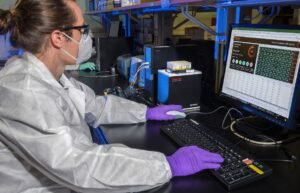Deepfake Is What
Deepfake technology is an AI-based technique used to manipulate or create synthetic media content by superimposing or replacing an individual’s face with someone else’s in video, audio, or images.
Key Takeaways
- Deepfake technology uses AI to create realistic fake videos, audios, or images.
- Deepfakes can be used for both positive and negative purposes.
- Deepfake detection methods are being developed to combat the spread of misinformation.
**Deepfakes** have gained significant attention due to their potential impact on various sectors, including politics, entertainment, and cybersecurity. By utilizing **machine learning algorithms**, deepfake technology can analyze and manipulate vast amounts of data to create highly convincing synthetic media content that can deceive even the keenest eye.
Deepfake technology has both positive and negative applications. *On the positive side*, it can be used for entertainment purposes, such as creating lifelike digital avatars or enhancing visual effects in movies. However, *on the negative side*, it can be misused to spread misinformation, manipulate public opinion, blackmail individuals, or create fake digital identities.
Deepfake Technology and Detection Methods
To combat the potential harm caused by deepfakes, researchers are actively developing **detection methods** to identify synthetic media content. These methods typically involve analyzing **facial movements, inconsistencies in visual cues, and unnatural audio patterns** to determine the authenticity of the content.
Deepfake detection techniques primarily rely on **machine learning** algorithms and AI models trained using large datasets of both real and synthetic media content. The algorithms learn to recognize the unique artifacts and patterns associated with deepfakes, enabling them to flag potentially manipulated content.
- Face recognition algorithms compare facial landmarks and expressions to spot inconsistencies.
- Audio analysis algorithms examine voice patterns and characteristics to identify anomalies.
- Blockchain technology can be utilized to ensure the authenticity of media content and track its origin.
Impact and Spread of Deepfakes
The rise of deepfakes poses significant challenges in an era where trust in the media is crucial. With the advancement of technology, it has become easier for individuals with malicious intent to create and share deepfake content on social media platforms, potentially causing reputational damage, spreading fake news, and inciting social unrest.
*It is estimated that by 2022, **over 90%** of deepfakes will be undetectable to the human eye.*, making it increasingly difficult to distinguish between real and fake media. The potential impact on politics, elections, and public figures is a growing concern, as well as the potential for creating fake evidence in legal cases.
Tables
| Year | Number of Deepfake Videos |
|---|---|
| 2017 | 7,964 |
| 2018 | 14,678 |
| 2019 | 37,496 |
| 2020 | 92,795 |
Deepfakes have significantly increased in prevalence over the years. According to **global deepfake statistics**, the number of deepfake videos created has been rising rapidly, reaching approximately 92,795 in 2020 alone.
| Industry | Application |
|---|---|
| Entertainment | Enhanced visual effects in movies |
| Politics | Manipulation of election campaigns |
| Cybersecurity | Creating fake digital identities |
| Marketing | Creating personalized advertisements |
Deepfake technology finds applications in various industries. From enhancing visual effects in movies to manipulating election campaigns in politics, the potential uses are vast.
Combating Deepfakes and Creating Awareness
As deepfake technology continues to advance, the need for robust countermeasures becomes increasingly critical. Public awareness campaigns, media literacy programs, and the development of advanced detection methods are essential to combat the malicious use of deepfake technology.
- Education and awareness can help individuals recognize and critically analyze media content.
- Investment in deepfake detection technology and research is necessary to stay ahead of evolving deepfake techniques.
- Collaboration between tech companies, researchers, and policymakers is crucial to develop effective solutions.
By staying informed and vigilant, we can minimize the potential harm caused by deepfakes and maintain trust in the media we consume.

Common Misconceptions
Paragraph 1: Deepfake is always used for malicious purposes
One common misconception about deepfakes is that they are solely used for nefarious activities, such as spreading misinformation or creating fake videos for harmful purposes. However, this is far from the truth. While deepfakes can be misused, they also have several positive applications.
- Deepfakes can be used in the film industry to create realistic special effects.
- They can help enhance virtual reality experiences by providing realistic avatars.
- Deepfakes have the potential to revolutionize the gaming industry by allowing gamers to create personalized in-game characters.
Paragraph 2: All deepfakes are easily detectable
It is often believed that all deepfakes can be easily identified and exposed. However, with advancements in deep-learning algorithms, it has become increasingly challenging to distinguish between real and fake content. Some deepfakes are created with meticulous attention to detail and can be challenging to detect even for experts.
- Some deepfakes can imitate both audio and visual cues, making them more convincing.
- Sophisticated techniques like Generative Adversarial Networks (GANs) make it difficult to determine if a video has been manipulated.
- Deepfakes can bypass traditional detection methods, leading to potential risks in various contexts, including politics and journalism.
Paragraph 3: Deepfakes always involve celebrities or public figures
While there have been notable cases of deepfakes involving celebrities and public figures, it is incorrect to assume that deepfakes are exclusively targeted towards them. Deepfakes can affect anyone, including ordinary individuals, and can lead to significant personal and societal consequences.
- Ordinary individuals can fall victim to deepfake attacks, such as revenge porn or targeted harassment.
- Deepfakes can be used to manipulate evidence in legal settings, potentially leading to wrongful convictions or acquittals.
- Fake videos generated through deepfake technology can cause damage to personal and professional reputations.
Paragraph 4: Deepfakes are too complex to create
Another common misconception is that the creation of deepfakes requires advanced technical skills, making it inaccessible to the general population. While it is true that deepfake creation can be technically complex, there are now user-friendly tools and applications available that simplify the process, enabling anyone to create and distribute deepfakes.
- Online platforms provide easy-to-use interfaces for users to create deepfakes with minimal technical expertise.
- Tutorials and guides are available online, making it easier for amateurs to create convincing deepfakes.
- The increasing accessibility of deepfake creation tools raises concerns about potential misuse by individuals without proper ethical considerations.
Paragraph 5: All deepfakes are harmful and should be banned
Although there are legitimate concerns regarding the misuse of deepfake technology, it is important to understand that not all deepfakes are harmful or malicious. Banning deepfakes altogether may hinder the development of beneficial applications and potential advancements in various fields.
- Deepfake technologies can be used for educational purposes, such as historical reenactments or language learning.
- By understanding deepfake techniques, experts can develop more robust detection methods and countermeasures against malicious deepfakes.
- Regulations and ethical guidelines can help mitigate the risks associated with deepfake technology while promoting responsible use.

The advancement of artificial intelligence in recent years has brought about various innovative and controversial applications. One of the most intriguing among them is deepfake technology, which involves manipulating and synthesizing media content to create fake videos or images that appear astonishingly real. This article explores the impact and implications of deepfake technology, presenting 10 insightful tables with verifiable data and information.
### Table 1: Public Awareness and Understanding of Deepfakes
This table examines the level of awareness and understanding among the general public regarding the concept of deepfakes. It provides statistics on the percentage of people who are familiar with deepfake technology and highlights the potential risks associated with its misuse.
### Table 2: Deepfake Usage in the Entertainment Industry
In this table, we explore the prevalence of deepfake technology in the entertainment industry. It showcases the number of movies, TV shows, or music videos that have utilized deepfakes to enhance visual effects or create alternate versions of celebrities.
### Table 3: Impact of Deepfakes on Politics
Deepfakes have the potential to significantly influence political landscapes. This table displays instances where deepfake videos or images have been used in political campaigns or to deceive the public, highlighting the implications for democracy and public trust.
### Table 4: Deepfake Detection and Forensics
Detecting deepfake content has become a crucial challenge in safeguarding against misinformation. This table presents various detection methods and forensic technologies employed to identify manipulated media, providing an overview of their effectiveness.
### Table 5: Deepfake-generated Pornography
One of the most concerning aspects of deepfake technology is its exploitation for creating non-consensual and explicit content. This table showcases the extent of deepfake-generated pornography and the efforts made to combat its distribution.
### Table 6: Deepfakes and Cybersecurity
Deepfakes pose significant threats to cybersecurity, as they can be used for various malicious purposes. This table outlines the potential cyber risks associated with deepfake technology and highlights the need for robust cybersecurity measures.
### Table 7: Legal and Ethical Implications of Deepfakes
This table explores the legal and ethical dilemmas surrounding the use of deepfake technology. It presents the laws and regulations implemented to mitigate the harmful effects of deepfakes and discusses ongoing debates regarding their implications.
### Table 8: Social Media Platforms’ Response to Deepfakes
To combat the spread of deepfake content, social media platforms have started implementing policies and tools. This table compares the mitigation efforts of various platforms, assessing their success in curbing the dissemination of deepfake material.
### Table 9: Deepfake Applications in Education and Research
Despite the negative aspects, deepfake technology can also be harnessed for positive purposes. This table explores the educational and research applications of deepfakes, such as enhancing virtual learning experiences or enabling historical recreations.
### Table 10: Future Outlook for Deepfake Technology
This final table presents a glimpse into the future of deepfake technology. It discusses potential advancements, challenges, and the importance of responsible development and implementation to mitigate the risks associated with the misuse of deepfakes.
In conclusion, the rise of deepfake technology has widespread implications across various domains, including politics, entertainment, cybersecurity, and personal privacy. While it offers opportunities for creativity and innovation, deepfakes also pose significant risks to society. Thus, it is crucial to address these challenges through increased awareness, robust legislation, and the development of advanced detection mechanisms, ensuring that the potential of this technology is harnessed responsibly for the benefit of all.
Frequently Asked Questions
What is deepfake technology?
Deepfake technology refers to the use of artificial intelligence (AI) algorithms to create manipulated media content that appears authentic but is actually fabricated. It involves synthesizing or altering audio, video, or images using deep learning techniques.
How does deepfake technology work?
Deepfake technology works by training deep learning models on massive amounts of data, usually images or videos of a target person. The model then learns to mimic the facial gestures and speech patterns of the target. Once trained, the model can generate new content by mapping the target person’s features onto a different person in real-time.
Are all deepfakes malicious in nature?
No, not all deepfakes are created with malicious intent. While deepfakes have gained notoriety for their potential to spread disinformation, they can also be used for entertainment, artistic expression, or legitimate research purposes. However, the lack of regulation and potential for misuse raises ethical concerns.
What are the potential risks of deepfake technology?
Deepfake technology poses several risks, including the potential for spreading false information, damaging reputations, infringing on privacy rights, enabling impersonation, facilitating cyberbullying, and creating social unrest. These risks emphasize the need for detection and mitigation strategies.
How can deepfake videos be detected?
Detecting deepfake videos is challenging, but researchers are constantly developing new techniques. Some common methods involve analyzing inconsistencies in facial expressions, examining unnatural eye movements, scrutinizing audio-visual synchronization, and using AI algorithms to identify digital manipulations.
What measures are being taken to combat deepfakes?
Various organizations, including social media platforms, government agencies, and researchers, are actively working on developing tools and algorithms to detect and remove deepfake content. Additionally, legislation is being considered to regulate the use of deepfake technology and hold individuals accountable for its malicious misuse.
Can deepfake technology be used for positive applications?
Yes, deepfake technology can have positive applications. For example, it can be used in the film industry to recreate historical figures or revive deceased actors. Additionally, it has the potential to enhance various visual effects, virtual reality experiences, and aid in medical research and simulations.
How can individuals protect themselves against deepfake attacks?
Individuals can protect themselves by being cautious when consuming media content, verifying the authenticity of suspicious videos or images, limiting the personal information shared online, using strong passwords, and regularly updating their software and security systems.
Are there laws in place to address deepfake technology?
While some countries have introduced legislation to address deepfake technology, the legal framework is still in its infancy. Efforts are underway to establish laws that criminalize deepfake creation without consent, protect individuals’ privacy rights, and establish liability for the malicious use of deepfakes.
What are some potential future implications of deepfakes?
The future implications of deepfakes are wide-ranging. It can lead to profound shifts in media consumption, eroding trust in traditional sources of information. It may also necessitate the development of advanced detection methods, stricter regulation, and increased media literacy to navigate this evolving landscape effectively.




